From the history of the Kronstadt shipyards
The Kronstadt fortress and the city of Kronstadt, as you know, have their origin in Fort Kronshlot, founded on the island of Kotlin in 1704. Since then, the defense of the capital has been one of the main royal concerns. For this, the Russian fleet in the Baltic Sea and the coastal fortress of Kronstadt were created. A lot of books and articles have been written about this fortress and the city of the same name of the Petrine era, but they are mainly devoted to fortresses. However, not only its forts are famous for Kronstadt, Peter the Great, given the favorable military-strategic location of Fr. Kotlin paid great attention to his shipyards. This is understandable, because soon after laying the first fortress on the island, Kronshlot became the main base of the young Baltic fleet.
The first mention of Konshlot shipbuilding refers to 7 in August 1705: Vice Admiral Cornelius Cruys reported to Peter I that under the guidance of the old scarf bottom (Bundar - a small one-mast vessel with a pointed nose section and a large forward slant) a flat-bottomed floating battery, also used to lift wrecks), on which are installed two 12-and five 6-pounders.
In 1707, on about. Kotlin repaired bots for ships Kronshlot squadron. In spite of the worse working conditions in comparison with Petersburg, it was here that three small shnyavs (sailing three-masted military vessels for exploration and messenger services) and a bombardment ship arrived to be completed.
According to the letter of Cruys to the commander-in-chief of the naval forces of Russia, Admiral F.M. Apraksinu, 9 September 1713, in Kronshlot, transported five uncompleted brigantines laid down on the Luga River in 1712 on disassembled form, but then dismantled, according to Peter I's decree on 27 June 1713, Cruise assured Apraksin that these ships would be reassembled as soon as the weather permits, as well as the other dismantled brigantines, whose arrival was expected. There were eight such vessels in total.
In the autumn of the same year about. Kotlin arrived with the inspection of Peter I and "Mr. Bass" (as the Chief Shipbuilder at that time was called) I.М. Golovin. The king recognized as valid all the ships of the Kotlin squadron, except "St. Anthony ”, who, due to rottenness, recommended redoing it into a brander (a vessel filled with flammable and explosive substances and intended to set fire or explode enemy ships). In April, 1714, under the leadership of the English fortifier and shipbuilder Eduard Lane, who served in Russia, supported Fr. Kotlin battleships "St. Catherine "and" Victoria ", as well as on" St. Anthony ", replaced the rotten masts, and on the frigate" St. Pavel "made repair of the stem. Judging by the report of the captain-commander Schelting to Count Apraksin, at the beginning of May of the same year all the Kronshlot battleships underwent a keening, during which their underwater parts were inspected, repaired and painted under the guidance of Petersburg shipwrights Naya and Brown. In the autumn of 1714, the battleships Gabriel, Raphael, and Pearl were repaired, and in the winter, the repairs of Pernova, Randolph, and Arondel.
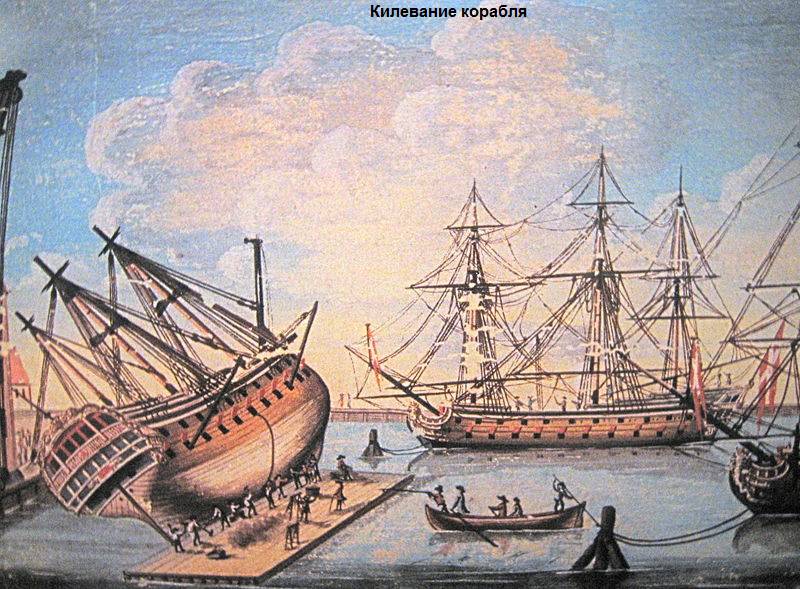
Due to the shortage of workers and materials, the state of affairs at the Kronshlot shipyards was not very good, therefore, in early December 1714, Peter arrived here, under whose leadership the development of the grandiose project of Kronshlot reorganization, realized with some changes, began Petra Already in 1715, things went much faster: in the spring, almost simultaneously, major repairs were carried out on battleships Leferm, Pernov and Arondel, as well as the frigate Sv. Yaks ", which was decided to" roll "(tilt the ship to repair damage in the underwater part). Here on the ships "Narva", "Shlisselburg", "Pearl", "St. Catherine ”and“ Raphael ”, as well as on the frigate“ Esperance ”, replaced rotten masts and made minor repairs.
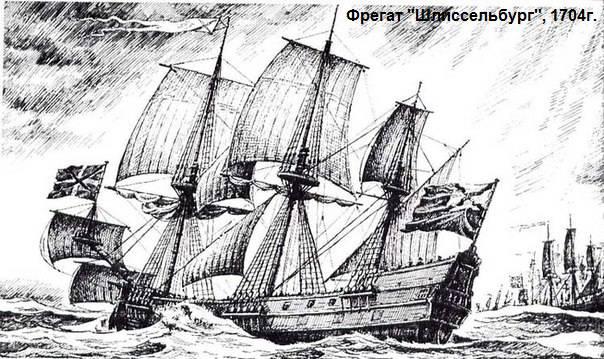
27 June 1715 of the year an unforeseen event occurred: a lightning bolt hit the battleship Narva standing on the internal Kronshlot raid, which caused it to explode and sank. Within a few days, Peter's instructions followed to raise the ship at all costs, as sand was quickly applied to it, and the resulting stranded could ruin the fairway. Peter suggested using pram, masts-lighter (a special vessel for lifting masts and ship-killing of ships) and two evers (small single-masted ships) for lifting. A month later, in a letter to the tsar's secretary Makarov, Fedosey Sklyaev, one of the best shipbuilders of Peter the Great, informed that it was useless to repair the sank “Narva”, and if they withstand the stern beams, they would try to lift the ship completely, not in parts. However, it was possible to do this much later, in the 1723 year, with the help of a diver, called from Amsterdam, and lighter masts, which arrived on Fr. Kotlin in 1722.
At the beginning of 1716, the construction of 20 island boats adapted to the skerry conditions and 20 boats for them began in Kronshlot. At the same time, intensive fleet repair continued. So, on the ships "London", "Leferm" and "Pernov" are replaced rotten masts. A special place was given to painting work, for which English painters produced special paints in St. Petersburg, which were then delivered to Fr. Kotlin.
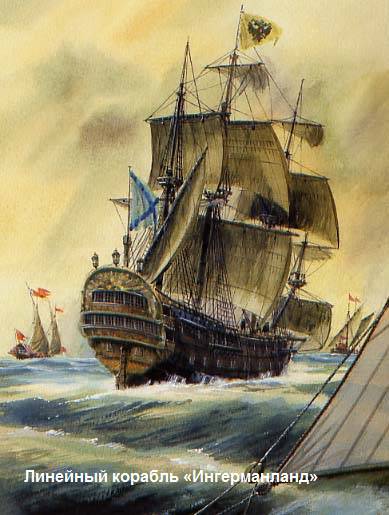
After some lull, the ship works in 1717, turned around with a new force. In the spring, on Kotlin, 13 bots were built of oak and the same number of boats to them, later sent to the capital. On June 3 of the same year, returned to the ship master Brown, who headed the shipbuilding and ship repair. Immediately after his arrival in Kronshlot, Prince Alexander began to redo the masts on the kick, and later they began to intensively heave the ships of the Kotlin squadron. The first to repair the flagship of Peter I "Ingermanland." For work on the ship "Lansdou" Brown called several St. Petersburg artisans. In mid-October 1717, the ship "Britain" came to overhaul in Kronshlot.
Judging by the decree of Peter I from 13 November 1718 on the construction of boat barns in Kronshlot, not only all the ships of the Kotlin squadron could be provided with boats, but also to create their reserve ashore. Taking care of expanding the scope of repair work, Master Browne requested in February 1718 of the year 120 carpenters from the regiments of Ostrovsky and Tolbukhin stationed on Kotlin. An interesting fact became known from the Cruise report to the Senate from 10 in March of the same year: forty military ships could be built or overhauled at the same time in the unfinished Kronshlot harbor; and this despite the fact that the famous Peter the Great Canal began to be built only two months later. A special cluster of ships and vessels was observed in the autumn of 1718, when at the same time Neptunus, Moscow, Shlisselburg, Le Farms, Riga, Sv. Catherine "and" Ingermanland. " At the vacant places in the harbor six ponds were built (fire-fighting vessels), as well as privateers (privately owned ships armed to attack the enemy’s merchant ships), galleys and boats.
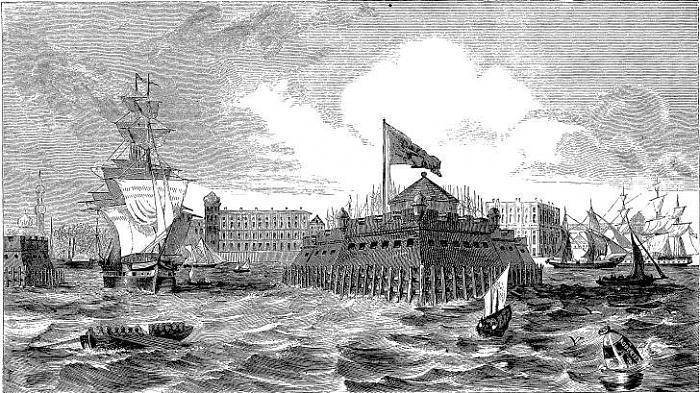
At the beginning of 1719, the old ships Archangel Michael and Gavriil were installed at the place of the Leferm and Riga ships that were handed over to the Admiralty, but in January of the same year the shipmaster informed Admiral Apraksin through captain Sivers that for repair they are unsuitable, offering to flood them in Rogervik, where the construction of a new port was planned. Over the course of the year, six Evers, Revel, Gangut and London ships, as well as the Ingermanland and Shlisselburg ships were repaired in Kronshlot.
Petrovsky mechanic and fortifier Anisim Malyarov took an active part in the repair of Gangut, which was under the special tutelage of the tsar, therefore the 17 of May 1719 was already operational on the ship. Even more attention was paid to the battleship "Lesnoy", which got off the fairway and ran aground at about. Kotlin in May of the same year. Works on his rise led by A.D. Menshikov, ship masters Sklyayev and Franz helped him. 29 June Menshikov reported that the ship with great difficulty entered into Kotlinskaya harbor, after which it is necessary to log out and install new masts. It took more than a month before the ship "Forest" regained buoyancy. Of the eight who came to Kronshlot for the repair of ships, four were killed in September: “Ingermanland”, “St. Alexander "," Moscow "and" St. Catherine". These facts speak of the fragility of the battleships of those years: they often had to be thoroughly repaired twice, and sometimes (like the "Ingermanland") even three times a year. In addition to the Russian ships, in the fall of Kotlinsky harbor in the autumn of 1719, the Vahmeister and Karl Kron Wapen frigates seized from the Swedes were repaired.
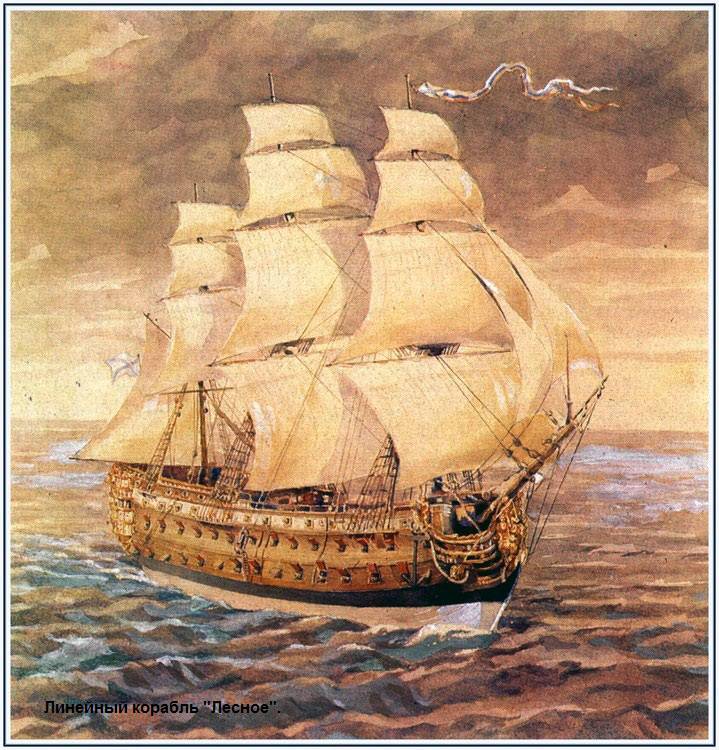
Gradually, many ships gathered in Kronshlot, a survey of which showed that they were unsuitable for repair. At the direction of Peter I, the ships flooded on the approaches to Kotlin, thereby blocking the path of the Swedish ships. 1720 was relatively quiet for Kronshlot ships. As in previous years, most of the ships were in the spring kilevanie. For the winter and spring of 1721, the repair of the ships Gangut and Lesnoye had to be completed. At the same time, work on the completion of new St. Petersburg ships began in Kronshlot. - “St. Peter "and" Panteleimon-Victoria. " In June of the same year, in accordance with the resolution of the Admiralty Colleges and Cruis’s instructions, the repair of the Poltava and Raphael ships damaged by the storm at the beginning of the campaign, the Friedemaker, as well as the Samson frigate, the Prince Alexander kick and captured from the Swedes shniav "Evva Eleanor" to "Poluks." In July, on the orders of Peter I, the masts were shortened on the Friedrichstadt ship, which made it easier to fly. In August, Astrakhan, “St. Alexander "and" Moscow ". At the same time, by decree of Peter I, five more ships assigned to participate in the Madagascar expedition were repaired.
Even more intensive fleet repair turned on about. Kotlin in 1722 year: a significant amount of work was carried out on the ships "St. Alexander ”,“ Revel ”,“ Marlburg ”and“ Shlisselburg ”, as well as“ Ingermanlandia ”and“ Moscow ”; on the frigate Amsterdam-galea, in particular, it was decided to equip skippers and boatswain's “closets” and move the commander’s cabin forward. Simultaneously unfolded a large fleet construction. Interestingly, those ships that were planned to be commissioned in the next two to three years, it was decided, under Peter’s instructions, to be built only for a certain period of time - from May to the first frost, in order to improve their quality. Cruyss's proposal to move anchor plants from Novaya Ladoga to Kronshlot, where they will be able to work on cheaper coal imported from England, at 1 rubles is worthy of note. and 11 hryvnia instead of 2 rub. for pounds. Measures were taken to improve the quality of ship materials.
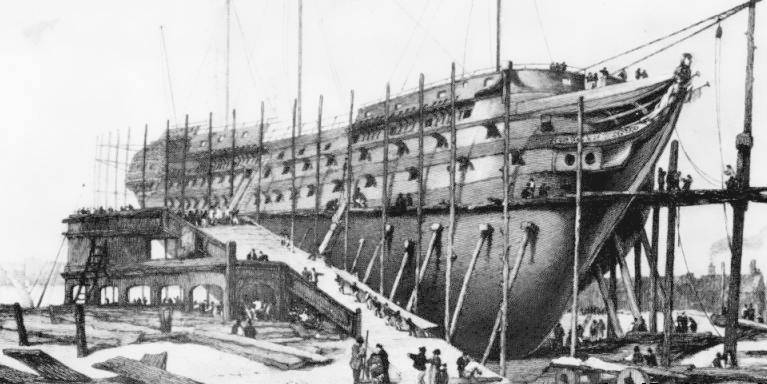
In 1722, at least two shipyards already existed on Kotlin, and work was carried out both in the old harbor, where ships were usually repaired, and in the new one. Confirmation that Kotlinsky shipbuilders performed the main work on ship repair on the Russian coast of the Baltic Sea, is the order of Rear Admiral Zmayevich, which refers to the production of minor repairs in Revel who arrived from Helsinki (Helsinki) finstock and large - on about. Kotlin. It was in Kronstadt (in 1722, in connection with the construction of the second Kotlin fortress, Kronshlot was renamed to Kronstadt), Admiral-General Apraksin arrived in September 1722 to learn more about the construction and repair of ships. In the fall of the same year, the bots were repaired here, supplying the fleet during the campaign period with provisions. For the construction of large ships began to build boathouses. In addition to galleys, bots and boats in the Kotlin harbors, more than twenty warships were being repaired, five of which were in the capital: Gangut, St. Peter ”,“ Friedemaker ”,“ Panteleimon-Victoria ”and Kukronslot gukor. The nature of the work performed can be judged, for example, by the ship "Panteleimon-Victoria" on the basis of a report written by its commander Wilster, addressed to Ober-Sarweyer, I.M. Golovin 14 July 1723 g. From this document it is clear that the ship was going to sheathe boards of the type "Gangut" and "Forest", and in the stern thicker than in the bow and the middle part; sand ballast was replaced with cast iron, and the hold was proposed to be redone so that the stern was larger than before the repair, the alteration touched the spars: the masts were shortened by two, and the tops were three feet. It should also be added that the repair of ships and ships was usually carried out under the guidance of the same ship masters who built them.
In 1724, on about. Kotlin, in addition to the continued construction of the slings and the sea channel, began to build docks. The management of these works by decree of 5 in October 1724 was transferred to the Admiralty Collegiums. The first use of the docks can be attributed to the following case: during a prolonged storm (July 19-25) at the fort Krasnaya Gorka, the battleship Moscow, Marlburg, Sv. Mikhail "," Poltava ", as well as the frigates" Kisken "and" Amsterdam-Galey "; The unusually short time to repair nine ships (the Kronstadt shipbuilders, moreover, put in order the sailing armament on the ships Derbent, Rafail and the Wind Hund frigate) would have been impossible without the use of new ship-raising structures. As we see, the Kronstadt shipyards of the Peter the Great Era played an important role in the formation, development and maintenance of the Baltic fleet's combat effectiveness.
Sources:
Yakovlev I. Ships and shipyards. L .: Shipbuilding, 1973. C. 63-71.
Rozadeev B. Kronstadt (architectural sketch). M .: stroiizdat. 1977. C. 47-54 ,.
Simonov L. In the shipyards of Kronshlot. // Navy. 1978. No.8. C.34-37.
Bogatyrev I. Kotlinsky shipyards. // Shipbuilding. 1975. No. 9. C.56-58.
Tyaptin A. Shipbuilding under Peter I. // Sea collection. 1983. No.7. C.48-53.
Skorikov Yu., Razdolgin A. Kronstadt fortress. L .: Stroyizdat. 1988. C. 4-17.
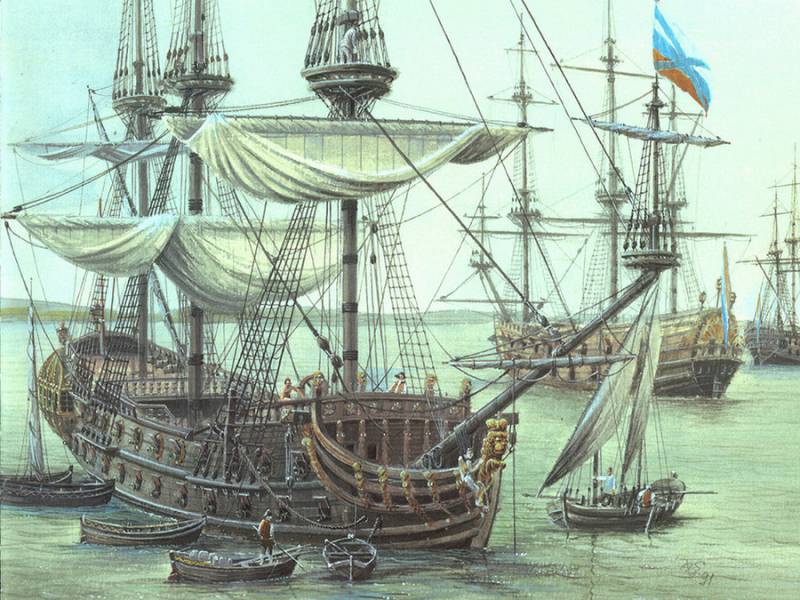
Information